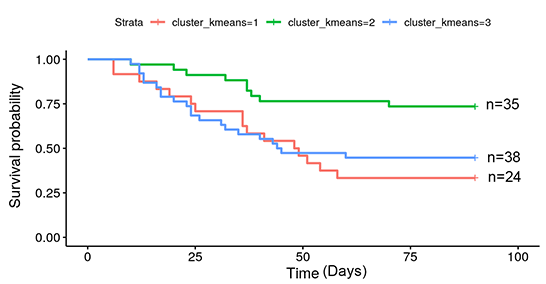Abstract
Introduction: We investigated association of phenotypes based on functional imaging biomarkers with mortality in patients with ARDS.
Methods: Design: two-center prospective observational study in adult COVID-19 patients with an indication for CT within 72 h of ARDS, approved by ethics committee. CT images were acquired at PEEP 5 and 15 cmH2O, segmented, and matched by an image-registration algorithm. Variables of local lung function and parametric response maps, and their spatial distribution were included in a K-means clustering model. Time-to-death censored at day 90 was analyzed by a Cox hazards model adjusted on age sex and BMI, with ventilator-free days (VFD) at 90 days as secondary outcome.
Results: In 97 included patients, 3 clusters were identified; and one with less PEEP-inducered recruitment and more caudal ventilation had a significantly lower mortality (HR=0.30, 95%CI=0.13-0.69). The functional imaging cluster analysis predicted VFD (p<0.001), driven by local biomechanical features such as recruitment, overdistension, tissue deformation, or their spatial features.
Conclusions: Key features of local lung biomechanics as revealed by functional CT imaging predict clinical outcome in mechanically ventilated Covid-19 ARDS patients. Such local lung behavior is a promising approach for patient stratification in clinical trials and a novel therapeutic target for personalized mechanical ventilation in patients with ARDS.

Fig. 1